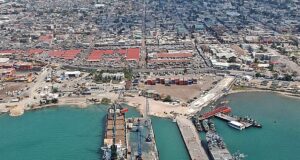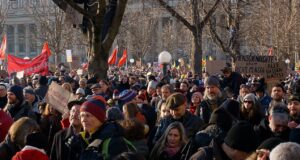January 8th, 2017
By Davis Florick – Senior Fellow
North Korea’s nuclear and missile weapons programs have drawn considerable attention, yet they mask critical military vulnerabilities. For decades, Pyongyang has focused on developing nuclear and missile systems at the expense of its conventional forces and the welfare of its people. Additionally, it has relied solely on offensive systems. Rather than investing in active defenses, particularly anti-aircraft and anti-missile assets, the North utilizes more affordable, passive defenses such as underground facilities. One of the major drawbacks to this approach is that it means the United States, South Korea, and Japan can target North Korean offensive capabilities with impunity once they are located. To exploit this opportunity, the US and its allies could and should expand and modernize their intelligence collection capabilities to detect and track North Korean military assets and develop the necessary missile systems to strike when needed. In so doing, Washington, Seoul, and Tokyo will be better able to credibly hold Pyongyang’s offensive systems at risk.
Over many decades, the Kim regime has devoted considerable resources to the development of nuclear weapons and, to a lesser extent, chemical and biological weapons. If employed, these capabilities are intended to impose intolerable costs upon the US, South Korea, and Japan. Thus, North Korea is attempting to use the threat of employing its nuclear, chemical, and biological arsenal to coerce the US and its allies into acquiescing to Pyongyang’s demands. To a significant degree, these weapons have come to replace conventional forces as the North’s primary means of challenging its enemies. Therefore, these capabilities are not only a tool for regime survival, but also may well be used for offensive warfighting operations. Via his byungjin line, Kim Jong-un has gone so far as to enshrine nuclear weapons – along with economic growth – as one of the two pillars of North Korea’s future development.
To employ its nuclear, chemical, and biological weapons, the North has developed a wide variety of ground- and submarine-based missile systems. These capabilities are designed to complicate the US and its allies’ ability to defend against the North Korean threat. Additionally, Pyongyang’s long-range artillery and multiple-launch rocket systems are located near the border with South Korea, thereby providing another layer of strike systems able of threatening US regional forces and South Korean high value assets. Armed with nuclear, chemical, biological, or conventional munitions, the North’s offensive capabilities are meant to overwhelm US and allied defenses and inflict unacceptable losses.
Nevertheless, although North Korea is advancing its nuclear and missile capabilities and retains a sizeable stockpile of chemical and biological weapons, it has failed to develop sufficient air and missile defenses needed to effectively counter adversary operations. These systems are the only means to intercept hostile aircraft and missiles before they strike. Without such capabilities, North Korea must rely on other techniques to enhance force protection.
The Kim regime prioritizes passive defenses to improve the survivability of its strike systems. Day-to-day, many of the North’s missiles and long-range artillery assets are in underground facilities. Should a conflict occur, Pyongyang is investing in mobile missile launchers, solid-fuel engines, and a multitude of launching areas to shorten the time the US and its allies have to locate, track, and interdict these systems prior to launch. Once fired, North Korea would then return its remaining strike capabilities to underground facilities to rearm for further strikes and hide from a US and allied response. Additionally, Pyongyang co-locates its nuclear, chemical, biological, and conventional warheads in an effort to confuse Washington, Seoul, and Tokyo prior to launch – in the hope that this might create caution regarding preemptive options. Ultimately, the Kim regime wants a range of capabilities that could be employed preemptively while also being survivable against US and allied aggression.
North Korea’s approach to defense, relying on passive concepts, is more affordable than active air and missile defenses, but is more limited. Pyongyang’s missile and long-range artillery capabilities must be hidden unless in use. Even when employed, its offensive systems cannot venture too far from their hiding sites because they are highly susceptible to an adversary counter-strike. Thus, reliance on passive defenses creates mobility challenges which help the US and its allies detect, track, and interdict North Korean systems.
While underground, the safety of North Korea’s weapons cannot be ensured either. Absent active defenses, the Kim regime is gambling that its dig-ins and tunnels are either unknown or too deeply buried for US and allied strike options. Given North Korea’s small size, even if the Korean People’s Army (KPA) could conceal hide sites today, time is not on its side. North Korean territory and mountainous terrain – ideally suited for hide sites – are limited. US and allied intelligence collection capabilities can improve and thus outpace the addition of possible North Korean underground options.
The US and its allies must continue to invest in intelligence capabilities to maximize their ability to collect information within North Korean territory. Potential enhancements should focus on cyberspace, human, outer space, and overhead terrestrial data collection. Over time, expanding and modernizing these capabilities will enhance coverage over North Korea. The objective must be to possess persistent observations of the Kim regime’s most sensitive targets, including the bases and staging areas for the KPA’s missile and long-range artillery assets. Observing central locations will help Washington, Seoul, and Tokyo track Pyongyang’s units. Furthermore, it will reduce the uncertainty over where targets may deploy, thus minimizing the challenges of detecting, tracking, and defeating the North’s missiles and long-range artillery.
Moreover, the survivability of Pyongyang’s underground facilities is a function of the quality and quantity of US and allied offensive systems. To meet the threat posed by North Korea, the US and its allies should expand and modernize their precision strike systems. To do so, Washington, Seoul, and Tokyo must develop a variety of regional ballistic and cruise missile capabilities. Missile systems provide promptness in responding to or preventing aggression by Pyongyang. Possessing both ballistic and cruise missile systems would result in multiple flight trajectory options which complicate any effort by North Korea to invest in missile defense systems. Something as simple as deploying these assets during a crisis would demonstrate US and allied resolve. Thus, for both military and political reasons, ballistic and cruise missile capabilities present unique value.
While the US and South Korea only need to enhance the diversity of their respective strike options, Japan is currently developing its first such capabilities with the purchase of the Joint Strike Missile for its planned F-35A fleet and a plan to assess the procurement of the Joint Air-to-Surface Standoff Missile-Extended Range (JASSM-ER) for its F-15J fleet. But given its own domestic arms industry, Tokyo should also seek to develop its own missile to be launched from air, ground, and sea platforms. Initial work should focus on a ground-based system, as this requires the most basic launch and logistical structure. A broad-platform intermediate-range cruise missile will provide Japan with a further increased capability to deny North Korea any perceived military advantage.
Washington should focus on expanding and modernizing its ground-based, short-range ballistic and cruise missiles. Mobile ground-launched systems would provide the US with an additional means to rapidly impose costs upon North Korea. Confronted with US, South Korean, and Japanese systems, North Korea would face an increasingly dire military situation. These capabilities would also have applications against other potential adversaries. Moreover, such systems should be developed in a manner that ensures their range(s) could be easily extended. While remaining in compliance with the Intermediate-range Nuclear Forces Treaty today, this consideration would allow the US to adjust quickly if the Treaty were to be terminated.
By pursuing additional prompt strike options, advancing intelligence collection capabilities, and continuing to develop missile defense systems, the US and its allies will place Kim Jong-un in a difficult position. North Korea’s fragile economy cannot support an arms race. Pyongyang has already sacrificed active defenses in favor of additional offensive systems. Thus, should the US and its allies increase their investments, particularly in strike capabilities, North Korea would be rapidly outpaced. Better positioned to maximize a damage limitation strategy, Washington, Seoul, and Tokyo will have significantly undercut Pyongyang’s ability to coerce its neighbors.
Over the long term, weakening Kim Jong-un’s leverage will have a profound effect on regional dynamics. The US, South Korea, and Japan will be in a better position to respond militarily to North Korean acts of aggression. For instance, in a scenario where Pyongyang conducts missile tests over international or foreign territory, Washington, Seoul, and Tokyo will be free to shoot down the North’s missiles. With a reduced the ability to benefit from wider escalation, the North will effectively be deterred from increasing tension after a shoot down. Given that Kim Jong-un has predicated much of his rule on his missile and nuclear programs, denying him the ability to conduct missile tests successfully will send a powerful message to the Kim regime, the KPA, the North Korean people, and its patrons. While it will take time for this strategy to take effect, once the US, South Korea, and Japan enhance their defense posture, North Korea’s position will be increasingly untenable.
Image: a North Korean test firing of an SA-3 Goa surface-to-air missile, a system dating back to the early 1960s (Source: KCTV)
 Human Security Centre Human Rights and International Security Research
Human Security Centre Human Rights and International Security Research



